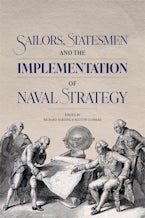
Order and Disorder in the British Navy, 1793-1815
Control, Resistance, Flogging and Hanging
- Description
- Contents
- Reviews
How did the British navy maintain authority among its potentially disorderly crews? And what order exactly did it wish to establish?
Churchill once famously remarked that he would not join the navy because it was "all rum, sodomy and the lash". How far this was true of the navy during the French Revolutionary and Napoleonic Wars is the subject of this important new book.
Summary punishments, courts martial, flogging and hanging were regularly made use of in this period to establish order in the navy. Based on extensive original research, including a detailed study of ships' captain's logs and muster tables, this book explores the concepts of order and disorder aboard ships and examines how order was preserved. It discusses the different sorts of disorder and why they occurred; argues that officers toosometimes pushed against the official order; and demonstrates that order was much more than the simple enforcement of the Articles of War.
The book argues that the behaviours that were punished, how and to what degree reveal what the navy saw as most resistive or dangerous to its authority and the order it wanted established. In addition, it considers the role of patronage in shaping order, outlining how this was affected by Admiralty moves to centralise appointments, and shows that acts of disorder were plentiful, and increasing, in this period, and that the imbalance in court martial outcomes for sailors, marines and warrant officers, in comparison to commissioned officers, points to a flawed system of justice. Overall, the book provides an extremely nuanced picture of order and how it was preserved.
Thomas Malcomson is a Professor in the School of Liberal Arts and Sciences at George Brown College, Toronto, Ontario. He completed his doctorate in history at York University, Toronto.
Churchill once famously remarked that he would not join the navy because it was "all rum, sodomy and the lash". How far this was true of the navy during the French Revolutionary and Napoleonic Wars is the subject of this important new book.
Summary punishments, courts martial, flogging and hanging were regularly made use of in this period to establish order in the navy. Based on extensive original research, including a detailed study of ships' captain's logs and muster tables, this book explores the concepts of order and disorder aboard ships and examines how order was preserved. It discusses the different sorts of disorder and why they occurred; argues that officers toosometimes pushed against the official order; and demonstrates that order was much more than the simple enforcement of the Articles of War.
The book argues that the behaviours that were punished, how and to what degree reveal what the navy saw as most resistive or dangerous to its authority and the order it wanted established. In addition, it considers the role of patronage in shaping order, outlining how this was affected by Admiralty moves to centralise appointments, and shows that acts of disorder were plentiful, and increasing, in this period, and that the imbalance in court martial outcomes for sailors, marines and warrant officers, in comparison to commissioned officers, points to a flawed system of justice. Overall, the book provides an extremely nuanced picture of order and how it was preserved.
Thomas Malcomson is a Professor in the School of Liberal Arts and Sciences at George Brown College, Toronto, Ontario. He completed his doctorate in history at York University, Toronto.
Introduction
Paper Forms of Control
Creating Order through Patronage and Material Incentives
Creating Order through Regimentation, Food, Tobacco and Alcohol, Religion and Language
Resistance
Illegitimate Activity: Theft, Profiteering and Embezzlement, and Sex
Opportunities for 'Disorder': The Coming of War, Shipwreck, Defeat and Drunkenness
The Responses
Conclusions
Appendix A: The Ships in the Sample, the Expected Complements, their Officers and the time period the Officers were in Command, within the Study
Appendix B: Tables
Works Cited
Paper Forms of Control
Creating Order through Patronage and Material Incentives
Creating Order through Regimentation, Food, Tobacco and Alcohol, Religion and Language
Resistance
Illegitimate Activity: Theft, Profiteering and Embezzlement, and Sex
Opportunities for 'Disorder': The Coming of War, Shipwreck, Defeat and Drunkenness
The Responses
Conclusions
Appendix A: The Ships in the Sample, the Expected Complements, their Officers and the time period the Officers were in Command, within the Study
Appendix B: Tables
Works Cited
"One of the great strengths of this book is that, at its best, it takes us right up to the limits of what is knowable, while displaying a refreshing honesty about the ways in which the evidence remains equivocal." INTERNATIONAL JOURNAL OF MARITIME HISTORY
"[T]he book's greatest strengths lay with the meticulous research and statistical analyses that the author undertook to support his arguments and conclusions . [E]xceptionally well written and well researched." THE NORTHERN MARINER
"[A]n erudite study of naval leadership during the latter days of the world's most powerful and sophisticated sailing navy. A vast array of data is presented, along with many naval historians' interpretations of the causes, affects and consequences of shipboard order- and disorder ... [A] worthy addition to any naval historian's library." SEA HISTORY
Hardcover
9781783271191
July 2016
£85.00 / $125.00
Ebook (EPDF)
9781782047728
July 2016
£24.99 / $29.95










